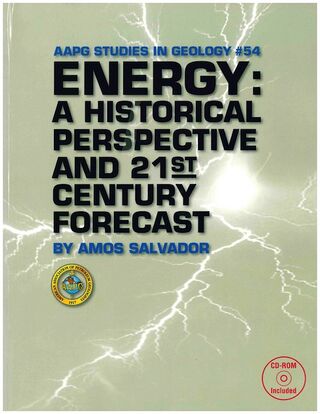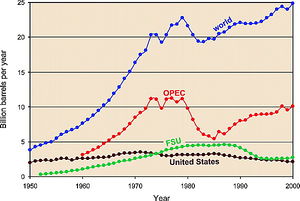Difference between revisions of "Oil as an energy source"
| Line 7: | Line 7: | ||
| topg = 34 | | topg = 34 | ||
| author = Dr. Amos Salvador | | author = Dr. Amos Salvador | ||
| − | | link = | + | | link = http://archives.datapages.com/data/alt-browse/aapg-special-volumes/sg54.htm |
| − | | pdf = | + | | pdf = http://archives.datapages.com/data/specpubs/study54/CHAPTER03/IMAGES/CHAPTER03.PDF |
| isbn = 0891810617 | | isbn = 0891810617 | ||
}} | }} | ||
Revision as of 15:54, 21 May 2014
| Energy: A Historical Perspective and 21st Century Forecast | |

| |
| Series | Studies in Geology |
|---|---|
| Chapter | Sources of Energy |
| Author | Dr. Amos Salvador |
| Link | Web page |
| PDF file (requires access) | |
Commercial production of oil started in the late 19th century, and since the late 1960s, oil and natural-gas liquids (NGL) have been the world's principal source of energy. As of 2005, the oil-producing countries of the Persian Gulf region provided 28% of the world's production and contained 65% of the world's reserves of oil. The Organization of Petroleum Exporting Countries (OPEC), which, in 2005, included the countries of the Persian Gulf region plus Algeria, Indonesia, Libya, Nigeria, and Venezuela, produced 40% of the world's oil and contained 79% of the oil reserves. Figure 1 depicts global oil production over a 50-year time span.

Three estimates of the ultimate worldwide oil recovery (3, 3.5, and 4 trillion bbl) include cumulative production, current reserves, natural-gas liquids, reserve growth, and enhanced oil recovery (EOR) additions to known oil fields and future discoveries. If any one of these estimates is correct, oil production will peak between 2025 and 2040 and then decline during the rest of the 21st century. Oil and its products will continue to be an important component of the world energy mix through the end of the century. In addition, conversion of natural gas to liquids (GTL) will provide a considerable increment to the supply of liquid fuels. The world will not run out of oil for a good many years yet.
See also[edit]
References[edit]
- ↑ Salvador, Amos, 2005, Energy-A historical perspective and 21st century forecast: AAPG Studies in Geology 54, 208 p.